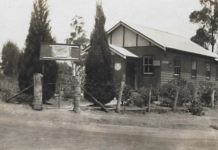
Back in the day I knew of many a Pastor – especially the male variety who spent their day in lieu playing golf or fishing. I could never swing the half a day required but a game of tennis was my kind of gig.
Last year I had my first serious hit in over a decade when I found
myself on court with my old doubles partner. 30 minutes of play passed and sure I was keeping the ball in court – but where was that killer backhand from the days of old?
But then.
I saw the ball coming like a Ross Clifford call to ‘do your theology with your bible in one hand and your newspaper in the other’ – and right off the sweet spot I hit a clean winner across court. So 1984! So glory days.
Just as in tennis – in brand and marketing finding the sweet spot is critical. My sense is that Pastors seem more conscious than ever of the need to tackle the brand of their church and I think this is a good thing. If the local church can find a missional brand sweet spot – a brand that help do more than just keep the church in play but also support your engagement with the local community and the sense of shared purpose and identity for the church itself – then it is a good thing!
You may be a brand sceptic but like many pursuits it has the good and the bad and I assert it can be redeemed. We can interact with branding and marketing in a way that is faithful to who we are as mission-shaped people. We can approach it with the lens of faith – via the framework of mission.
The framework I work with emerges out of my missiology. In this blog I want to introduce you to a brand framework by taking you to the familiar story of Paul in Athens (Acts 17). I look at Paul and I see a preacher find the communication sweet spot.
We know from Paul’s own testimony and the New Testament letters that he reflected significantly on the nature of the gospel message – the God story. Paul had wrestled with what were the essential elements of the Gospel for Jew, Gentile, Slave and Free. This is classically illustrated in this sermon – no mention of law but an emphasis on right relationship via the death and resurrection of Jesus (v31). Paul’s sense of identity and conviction that arose from such reflection also sits behind the boldness and passion of this sermon.
He was also one who dug deeply into his own story – owning his earlier role in empire and the religious elite whilst also reflecting on that cultural context. Also owning his weaknesses and indeed his strengths – what made him unique and the nature of his personality. He came to immerse his own story into his communications and reflectively allow his strengths to support the message he sought to announce. Here at Athens – as one educated in the Greco-Roman world he is able to speak with authority about the ‘unknown god’ and objects of worship.
Finally, he took the story of the local community seriously. When speaking to the keepers of the law that would be his starting point – but here in Athens he starts from their world and only then seeks to move to the Christ story.
As we can see from Diagram 1 below – this place of intersection between these three key stories leads us to Paul’s communication sweet spot.
Diagram 1 – The Pauline Sweet spot

We can take this model of Paul and adapt it to discovering the sweet spot of a missional brand for the local church. Your brand or visual presence, including your name – should arise from who uniquely you are. It is not to be an imported franchise or download. It must be a local incarnation.
A unique and missional brand emerges from a creative intersection. As per Diagram 2 the local Church has undertaken, hopefully intentionally – a time of discernment and learning as to what is at the core of the gospel of the Kingdom – for them. In branding we want to be true to the DNA of the Church in its discernment of the ‘God Story’.
Diagram 2 – On Way to Being a Church on Brand

Secondly, each Church community has its own distinct story – it’s very own ‘Church Story.’ It will be connected to its unique discernment of the God Story but there will be more.
What makes it unique as a community? Not just in terms of doing but in terms of being?
What is the flavour or personality of the Church in terms of worship, discipleship, doing community and engaging the community?
Thirdly, what is the flavour of the local community – the locality story? Where is the good – the footprints of the creator in the hopes and aspirations of ‘not-yet Jesus followers?’ Are there certain traits that would represent this community well?
If we are able to capture the above well – which will by necessity involve qualitative (e.g. interviews, focus groups) and quantitative research (e.g. surveys), we will have the raw material from which we can create something special. In terms of what will be utilised in a visual identity from these three circles – the something special is found in the areas of intersection. And the innermost point is the sweet spot we look for.
The areas of general intersection and the sweet spot itself will also provide a clear sense of how we want to be valued – how we want to be seen by those who encounter us. We will have some clarity about the points of uniqueness and the personality of the Church.
As we wrap the essence that is the above into a brand brief – with a good designer we can create a faithful visual identity. In extending from this an aligned and well-executed marketing plan – we have in place a supporting resource for building common purpose across the church. We have in place a resource that most certainly will not ‘do mission’ for the church – but will walk alongside every interaction to foster intrigue and interest among those the faith community invite to participate in the Kingdom of God.




































Great and clear article. Makes a good platform for discussion